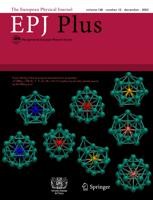Modelling the use of Beta Radiation in cancer treatment
New research pits the simulation of beta radiation doses in tumour treatment against an analytical method.
New York | Heidelberg, 27 September 2022
 Treating superficial skin tumours especially when they are located above cartilage or bone with beta radiation can help protect sensitive structures during the delivery of treatment.
Treating superficial skin tumours especially when they are located above cartilage or bone with beta radiation can help protect sensitive structures during the delivery of treatment.
The use of short-range beta radiation in cancer treatment is not without its disadvantages, however, especially when it comes to the measurement of radiation exposure — dosimetry. When experimental dosimetry is not feasible, researchers use simulations and calculations to study the interaction of the ionizing radiation with matter and estimate the radiation dose delivered to a target organ.
A new paper published in EPJ Plus and authored by Eduardo De Paiva, from the Division of Medical Physics at the Institute of Radiation Protection and Dosimetry, Rio de Janeiro, Brazil, and his colleagues, pits the gold standard of simulation techniques — Monte Carlo (MC) simulation — against an alternative analytic method, the Loevinger formula.
“We measured the dose of a treatment applicator using mathematical techniques — a simple technique, no experiment needed and no practical challenges,” De Paiva says. “The comparison of MC simulation and Loevinger formula on the setup of our research was the novelty of our study.”
Nonexperimental dosimetry techniques like MC simulation are advantageous for their ability to handle different geometries and materials, but MC simulations require heavy computation and this can impede their implementation.
Analytic methods are another set of techniques for dosimetry of beta radiation that can produce results faster than MC methods. Thus far, these methods have been less favoured because they are associated with lower accuracy.
The team used MC simulation and analytical calculation — the Loevinger formula — for dosimetry of radiation dose from a multiwell skin brachytherapy applicator with two beta sources. The results of the two approaches were compared to see how accurate the analytical method is.
“The Loevinger formula, which is a quick method for dosimetry showed a good agreement with gold standard Monte Carlo methods,” Paiva concluded. “Thus, the Loevinger formula can be used, as the basis of a dosimetry software, for straightforward dosimetry of beta sources in simple geometries.”
Reference: De Paiva, E., Robatjazi, M. & Pashazadeh, A. Calculations of beta radiation doses from multiwell Phosphorus-32 and Yttrium-90 applicators designed to be used in the treatment of superficial skin tumors: comparison of Monte Carlo and analytical methods. Eur. Phys. J. Plus 137, 916 (2022). https://doi.org/10.1140/epjp/s13360-022-03116-5
Further Information
For more information visit: www.epj.org
Services for Journalists
The full-text article is available here.
Contact
Sabine Lehr | Springer | Physics Editorial Department
tel +49-6221-487-8336 | sabine.lehr@springer.com
